Type Marian apparition | Shrine none | |
 | ||
Holy See approval 30 January 1226, during the pontificate of Pope Honorius III1587, during the pontificate of Pope Sixtus V Patronage Carmelites, Chile, Bolivia, Quiapo, Manila, New Manila, Quezon City, Malolos City, Bulacan, Catemaco, Aylesford, Roraima, Birkirkara, Jaboticabal, Valletta, Pernambuco, Higuerote, protection from harm, protection from dangerous situations, deliverance from Purgatory | ||
The history of our lady of mount carmel
Our Lady of Mount Carmel is the title given to the Blessed Virgin Mary in her role as patroness of the Carmelite Order. The first Carmelites were Christian hermits living on Mount Carmel in the Holy Land during the late 12th and early to mid-13th century. They built in the midst of their hermitages a chapel which they dedicated to the Blessed Virgin, whom they conceived of in chivalric terms as the "Lady of the place." Our Lady of Mount Carmel was adopted in the 19th century as the patron saint of Chile, in South America.
Contents
- The history of our lady of mount carmel
- The brown scapular of our lady of mount carmel
- History
- Carmelite devotion to Mary
- Prayer to the Blessed Mother of Mount Carmel
- Church teaching
- Association with Purgatory
- Apparitions
- Miracles
- Use in the peace movement
- Gallery of statues
- References
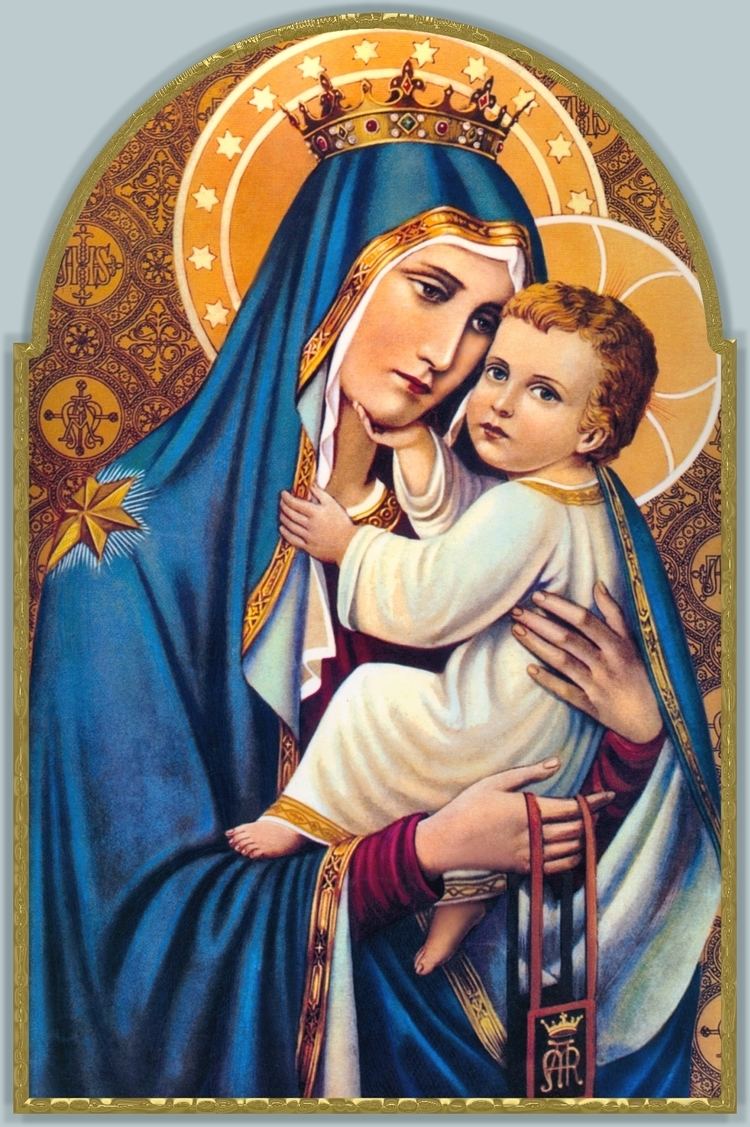
Since the 15th century, popular devotion to Our Lady of Mount Carmel has centered on the Scapular of Our Lady of Mount Carmel, also known as the Brown Scapular, a sacramental associated with promises of Mary's special aid for the salvation of the devoted wearer. Traditionally, Mary is said to have given the Scapular to an early Carmelite named Saint Simon Stock. The liturgical feast of Our Lady of Mount Carmel is celebrated on 16 July.

The solemn liturgical feast of Our Lady of Mount Carmel was probably first celebrated in England in the later part of the 14th century. Its object was thanksgiving to Mary, the patroness of the Carmelite Order, for the benefits she had accorded to it through its difficult early years. The institution of the feast may have come in the wake of the vindication of their title "Brothers of the Blessed Virgin Mary" at Cambridge, England in 1374. The date chosen was 17 July; on the European mainland this date conflicted with the feast of St. Alexis, requiring a shift to 16 July, which remains the Feast of Our Lady of Mount Carmel throughout the Catholic Church. The Latin poem "Flos Carmeli" (meaning "Flower of Carmel") first appears as the sequence for this Mass.

The brown scapular of our lady of mount carmel
History
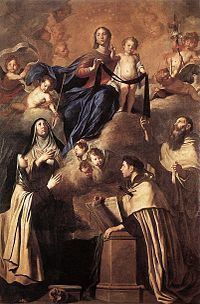
The Carmelite Order was the only religious order to be started in the Crusader States. In the 13th century, some of its people migrated west to England, setting up a chapter and being documented there about 1241-1242. A tradition first attested to in the late 14th century says that Saint Simon Stock, believed to be an early English prior general of the Carmelite Order soon after its migration to England, had a vision of the Blessed Virgin Mary in which she gave him the Brown Scapular. This formed part of the Carmelite habit after 1287. In Stock's vision, Mary promised that those who died wearing the scapular would be saved.
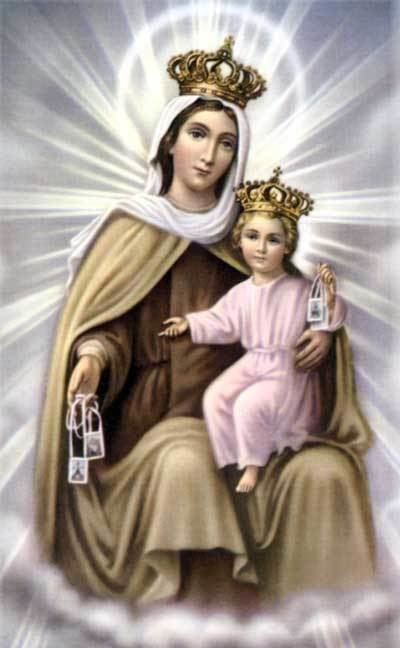
The Feast of Our Lady of Mount Carmel is known to many Catholic faithful as the "scapular feast," associated with the Brown Scapular of the Carmelite order. This is a devotional sacramental signifying the wearer's consecration to Mary and affiliation with the Carmelite order.
Based on available historical documentation, the liturgical feast of Our Lady of Mount Carmel did not originally have a specific association with the Brown Scapular or the tradition of Stock's vision of the Blessed Virgin Mary. This tradition grew gradually, as did the liturgical cult of St. Simon. The latter has been documented in Bordeaux, where Stock died, from the year 1435; in Ireland and England, from 1458; and in the rest of the Order, from 1564. Historians have long questioned whether Stock had the vision of Mary and the scapular. Although Simon Stock was never officially canonized, his feast day was celebrated in the church.
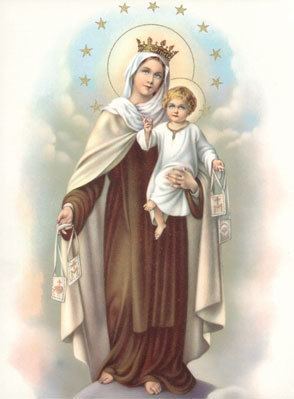
In 1642, a Carmelite named Fr. John Cheron published a document which he said was a 13th-century letter written by Saint Simon Stock's secretary, Peter Swanington. Since the early 20th century, historians have concluded that this letter was forged, likely by Cheron himself.
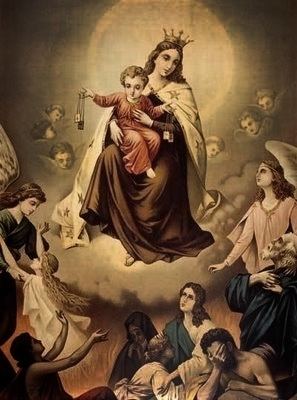
But Stock's vision was long embraced by many promoters of the scapular devotion. The forged Swanington letter claimed that 16 July 1251 was the date of the vision (16 July being the date of the Feast of Our Lady of Mount Carmel), which led for centuries to a strong association between this feast day and the scapular devotion.
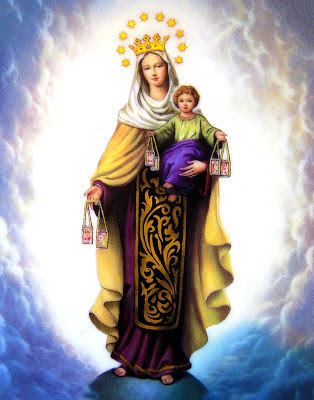
Also associated with Our Lady of Carmel was a papal bull saying that there was a Sabbatine Privilege associated with devotion to the saint; that is, that Until the late 1970s, the Catholic liturgy for that day expressed the scapular devotion. Vatican II resulted in scrutiny of the Feast of Our Lady of Mount Carmel, as well as that of Saint Simon Stock, because of the historical uncertainties about the origins. The liturgies were revised and, in the 21st century, neither, even in the Carmelite proper, makes reference to the scapular. The Carmelite convent of Aylesford, England, was restored and a relic of Saint Simon Stock was placed there in 1951. The saint's feast is celebrated in the places dedicated to him.

In Spain and other Spanish-speaking countries, there has been particular devotion to Our Lady of Mount Carmel, who has been adopted as a patron saint of several places, as she has been in other Catholic-majority countries. In addition, Carmen and María del Carmen have been popular given names for girls in Spanish-speaking countries. For example, an annual festival, known as Mamacha Carmen, is held in the highland Paucartambo District, Peru, featuring a procession with the Virgin and traditional dancers.
Carmelite devotion to Mary
The Carmelites consider the Blessed Virgin Mary to be a perfect model of the interior life of prayer and contemplation to which Carmelites aspire, as well as a model of virtue, in the person who was closest in life to Jesus Christ. She is seen as the one who points Christians most surely to Christ. As she says to the servants at the wedding at Cana, "Do whatever he [Jesus] tells you." Carmelites look to the Virgin Mary as a Spiritual Mother. The Stella Maris Monastery (Star of the Sea) on Mount Carmel, named after a traditional title of the Blessed Virgin Mary, is considered the spiritual headquarters of the order.
Fr. Gabriel of St. Mary Magdalene de' Pazzi, OCD, a revered authority on Carmelite spirituality, wrote that devotion to Our Lady of Mount Carmel means:
a special call to the interior life, which is preeminently a Marian life. Our Lady wants us to resemble her not only in our outward vesture but, far more, in heart and spirit. If we gaze into Mary's soul, we shall see that grace in her has flowered into a spiritual life of incalculable wealth: a life of recollection, prayer, uninterrupted oblation to God, continual contact, and intimate union with him. Mary's soul is a sanctuary reserved for God alone, where no human creature has ever left its trace, where love and zeal for the glory of God and the salvation of mankind reign supreme. [...] Those who want to live their devotion to Our Lady of Mt. Carmel to the full must follow Mary into the depths of her interior life. Carmel is the symbol of the contemplative life, the life wholly dedicated to the quest for God, wholly orientated towards intimacy with God; and the one who has best realized this highest of ideals is Our Lady herself, 'Queen and Splendor of Carmel'."
Prayer to the Blessed Mother of Mount Carmel
O most beautiful flower of Mt. Carmel, fruitful vine, splendor of Heaven, Blessed Mother of the Son of God, Immaculate Virgin, assist me in my necessity. O Star of the Sea, help me and show me you are my Mother. O Holy Mary, Mother of God, Queen of Heaven and earth, I humbly beseech you from the bottom of my heart to succor me in this necessity (make request). There are none that can withstand your power. O Mary, conceived without sin, pray for us who have recourse to thee. Sweet Mother I place this cause in your hands. Amen.
Church teaching
A 1996 doctrinal statement approved by the Congregation for Divine Worship and the Discipline of the Sacraments states that
"Devotion to Our Lady of Mount Carmel is bound to the history and spiritual values of the Order of the Brothers of the Blessed Virgin Mary of Mount Carmel and is expressed through the scapular. Thus, whoever receives the scapular becomes a member of the order and pledges him/herself to live according to its spirituality in accordance with the characteristics of his/her state in life."
According to the Church on the Brown Scapular:
"The scapular is a Marian habit or garment. It is both a sign and pledge. A sign of belonging to Mary; a pledge of her motherly protection, not only in this life but after death. As a sign, it is a conventional sign signifying three elements strictly joined: first, belonging to a religious family particularly devoted to Mary, especially dear to Mary, the Carmelite Order; second, consecration to Mary, devotion to and trust in her Immaculate Heart; third, an urge to become like Mary by imitating her virtues, above all her humility, chastity, and spirit of prayer."
Association with Purgatory
Since the Middle Ages, Our Lady of Mount Carmel has been related to purgatory, where souls are purged of sins in the fires. In some images, she is portrayed as accompanied with angels and souls wearing Brown Scapulars, who plead for her mediation. In 1613, the Church forbade images to be made of Our Lady of Mt. Carmel descending into purgatory, due to errors being preached about certain privileges associated with the Brown Scapular (known as "the Sabbatine Privilege").
That privilege appears in the noted Decree of the Holy Office (1613). It was inserted in its entirety (except for the words forbidding the painting of the pictures) into the list of the indulgences and privileges of the Confraternity of the Scapular of Mount Carmel. In the 21st century, the Carmelites do not promote the Sabbatine Privilege. They encourage a belief in Mary's general aid and prayerful assistance for their souls beyond death, especially her aid to those who devoutly wear the Brown Scapular, and commend devotion to Mary especially on Saturdays, which are dedicated to her.
Apparitions
Our Lady of Mount Carmel was seen in the apparitions of Cova da Iria in Fátima, Portugal, by Lúcia Santos during the Miracle of the Sun. She also appeared to Saint Simon Stock to whom she gave the Brown Scapular. The Garabandal apparitions, in Spain, were reported to be images of the Blessed Virgin Mary of Mount Carmel.
Miracles
In Palmi, Italy, the anniversary of the earthquake of 1894 is observed annually on 16 November. The earthquake had its epicenter in the city. An associated event has been classified as the "miracle of Our Lady of Mount Carmel." For 17 days preceding this earthquake, many of the faithful had reported strange eye movements and changes in the coloring of the face in a statue of Our Lady of Mount Carmel. The local and national press reported these occurrences.
In the evening of 16 November, the faithful improvised a procession carrying the statue of the Virgin of Carmel on their shoulders through the streets. When the procession reached the end of the city, a violent earthquake shook the whole district of Palmi, ruining most of the old houses along the way. But, only nine people died out of a population of about 15,000 inhabitants, as almost all of the population had been on the street to watch the procession and were not trapped inside the destroyed buildings. Therefore, the city commemorates the 1894 procession each year, accompanied by firecrackers, lights, and festive stalls.
The Catholic Church has officially recognized the miracle. On November 16, 1896 the statue of the Virgin was crowned, based on the decree issued September 22, 1895 by the Vatican Chapter.
Use in the peace movement
The first atomic bomb was exploded in the United States at the Trinity test site on 16 July 1945, near Alamogordo, New Mexico. The Catholic anti-war movement has built on the coincidence between this date and the Feast of Our Lady of Mount Carmel. In 1990, the Rev. Emmanuel Charles McCarthy, a priest of the Eastern Rite (Byzantine-Melkite) of the Catholic Church, initiated the "16 July Twenty-Four Hours Day of Prayer," for Forgiveness and Protection with Our Lady of Mount Carmel, at Trinity Site in the New Mexico desert. Each year on 16 July, a prayer vigil is conducted at the Trinity site to pray for peace and the elimination of nuclear weapons.
Gallery of statues
Statues of Our Lady of Mount Carmel usually depict her with a Brown scapular.
